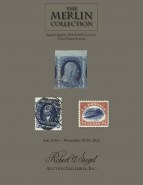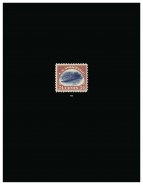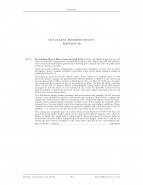⇚ Position 48 - 2012-11-28 Transaction Summary
Purchase Date:
2012-11-28
How Purchased:
Auction
Where Purchased:
Siegel Auction Galleries
Auction No.:
1034-The Merlin Collection
Lot No.:
522
Sound/Fault:
Fault
Catalogue Value:
$ 450,000
Realized:
$ 241,500
Seller:
Buyer:
Description
24c Carmine Rose & Blue, Center Inverted (C3a). Position 48, lightly hinged, deep rich colors and detailed impressions, remarkably fresh for this rarity, long and full perforations all around with bottom perforations showing part of guide line, two tiny thin spots at left are barely noticeable
VERY FINE AND CHOICE APPEARANCE. A BEAUTIFUL EXAMPLE OF THE 1918 24-CENT INVERTED "JENNY" ERROR. WITHOUT QUESTION THIS IS THE MOST FAMOUS STAMP IN AMERICAN PHILATELY.
According to Jenny by George Amick (Amos Press, 1986), the original sheet of 100 Inverted "Jenny" stamps was purchased for $24 by William T. Robey at the New York Avenue Branch Post Office window in Washington D.C., on May 14, 1918, one day after the stamp was first placed on sale at the main post office. On May 20, Robey sold his sheet for $15,000 to Eugene Klein, a Philadelphia stamp dealer. Klein had already arranged to sell the sheet to Col. Edward H. R. Green for $20,000. Colonel Green instructed Klein to divide the Inverted "Jenny" sheet into singles and blocks, and to sell all but a few key position blocks.
It is well-known among stamp specialists and professionals that examples of the Inverted "Jenny" come in different grades of freshness and condition. Many of the original 100 stamps were mistreated by collectors during the years, despite the stamps' rarity and value. Colonel Green himself allowed moisture to affect some of the stamps he retained. Other examples have become slightly toned from improper storage and climatic conditions. Hinge removal has caused thins and creases in numerous stamps, and a few have been "lost" to philately -- or nearly so, as in the case of the copy swept up in a vacuum cleaner.
This stamp was originally part of a block of four from Positions 47-48/57-58 that was owned by stamp dealer Eugene Klein. It was inherited by Klein's daughter who sold it to Robert A. Siegel. Mr. Siegel sold it to Raymond H. Weill, who placed it with two different anonymous collectors before being asked to break it into singles. Positions 57 and 58 are among the best-centered examples in the entire sheet, and all four are remarkably fresh.
With 2012 P.F. certificate
VERY FINE AND CHOICE APPEARANCE. A BEAUTIFUL EXAMPLE OF THE 1918 24-CENT INVERTED "JENNY" ERROR. WITHOUT QUESTION THIS IS THE MOST FAMOUS STAMP IN AMERICAN PHILATELY.
According to Jenny by George Amick (Amos Press, 1986), the original sheet of 100 Inverted "Jenny" stamps was purchased for $24 by William T. Robey at the New York Avenue Branch Post Office window in Washington D.C., on May 14, 1918, one day after the stamp was first placed on sale at the main post office. On May 20, Robey sold his sheet for $15,000 to Eugene Klein, a Philadelphia stamp dealer. Klein had already arranged to sell the sheet to Col. Edward H. R. Green for $20,000. Colonel Green instructed Klein to divide the Inverted "Jenny" sheet into singles and blocks, and to sell all but a few key position blocks.
It is well-known among stamp specialists and professionals that examples of the Inverted "Jenny" come in different grades of freshness and condition. Many of the original 100 stamps were mistreated by collectors during the years, despite the stamps' rarity and value. Colonel Green himself allowed moisture to affect some of the stamps he retained. Other examples have become slightly toned from improper storage and climatic conditions. Hinge removal has caused thins and creases in numerous stamps, and a few have been "lost" to philately -- or nearly so, as in the case of the copy swept up in a vacuum cleaner.
This stamp was originally part of a block of four from Positions 47-48/57-58 that was owned by stamp dealer Eugene Klein. It was inherited by Klein's daughter who sold it to Robert A. Siegel. Mr. Siegel sold it to Raymond H. Weill, who placed it with two different anonymous collectors before being asked to break it into singles. Positions 57 and 58 are among the best-centered examples in the entire sheet, and all four are remarkably fresh.
With 2012 P.F. certificate



